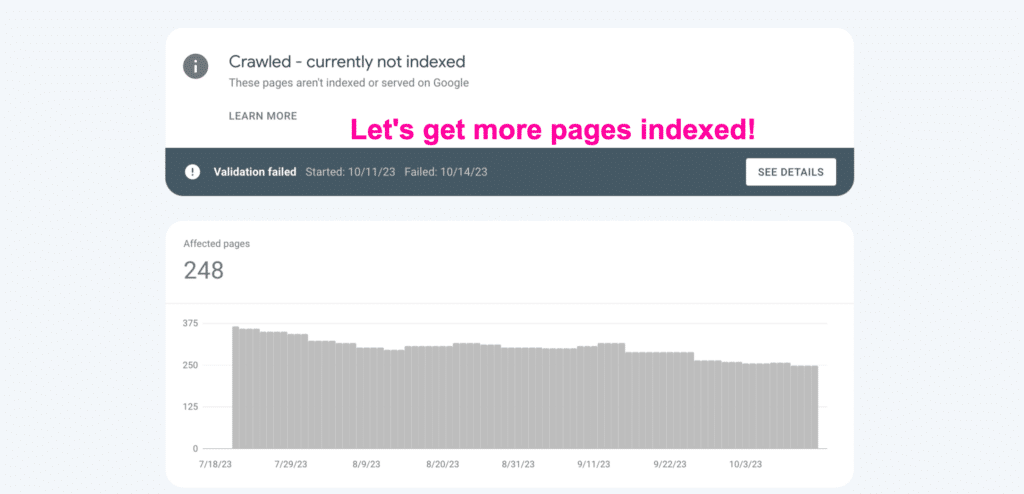If you’re here, you probably already know that adding your website to Google Search Console and along with a sitemap, might get your website crawled, but that doesn’t mean Google Includes it in their index. It’s a frustrating problem to have.
Basically Google is a saying “we know about this content, but we don’t think it is worthwhile to show to people”.
In this post I am going to cover my approach to reigniting traffic on a website that was plagued with this ‘Crawled — currently not indexed issue and has yielded positive results for friends that I advise. My approach focuses on onsite optimization as that is what you can directly improve quickly. Links, social signals and branded traffic do help, but they are hard ‘build’ and they require a good foundation — your site.
Why are you getting this ‘Crawled — currently not indexed’ ?

Google will regularly crawl sites, even new sites at a pretty high rate, but indexing is a different story. Google doesn’t index and serves everything it knows about.
To be direct, the reason your gettin this result is that your site is mediocre at best, and most likely shitty. With that your site likely has no external factors like links, social engagement or branded traffic to show Google that it is worth indexing. Sites that have those external factors can get away with more ‘mediocrity’.
Pretty much all of the sites that have with this issue, are sites that have focused purely on keyword research and publishing content, with little regard for if the site is actually ‘good’, and have amassed a hodge-podge of content.
So where do we start getting indexed?
1. Prune Mediocre Content
I’m not talking about just a few posts, I mean really un-publish a lot of content. 50% or more. Do note, I said un-publish. That means in wordpress turn it back to a draft. Get it out of the public eye but don’t delete the content. Maybe you’ll use it one day.
How do you know what is mediocre? There’s no written in stone method for it, but my approach is to simply ask myself, would I be proud to show this off to a group of industry professionals with my name on it?
For most content that is written by an generalist agency; the answer is no.
For many site this will require re-writing content.
2. Focus On Topical Authority While Pruning
As you’re going through the old content deciding what gets cut, try to narrow your content down to just a few categories that are closely related. In my experience Google does much better when it can look at a website and say this website is specifically about this niche. For example if you have a site about Golden Retrievers focus on cover the category of training in-depth and pruning your other content.
3. Fix Broken Links
As a used, broken links suck. Yet as website owners we lazily leave them in the content. Im guilty of it.
On most sites that are struggling to get SEO traction, I find hundred of broken links. On sites that are doing well with SEO, I find very few broken links. It seems like a clear correlation and one we can all agree impacts user experience.
Further more, when you think about it like Google, a site with broken links is a clear site of neglect.
Use the ‘broken link checker’ plugin for Wordpres to find and replace them easily.
4. Fix Core Web Vitals
Get a passing score on both mobile and desktop. No it is not the ‘end all, be all’ but it is ranking factor that is directly the result of your own effort and is fairly easy to fix. I’ve covered a lot about this on my blog here. Here are some related posts
How This Video Heavy Website Is Passing Core Web Vitals
3 Ways To Serve Images In Next-gen Format On A WordPress Site
WP Rocket Is My Plugin For Passing Core Web Vitals
5. Publish Adjacent Content.
If you’ve gotten everything done thus far, you’re going to notice nearly all of your pages indexing, and new content indexing at a quicker rate.
Going forward focus on publishing content that is adjacent to content you already have. This builds that topical authority. By adjacent I mean posts that would naturally link to your existing posts, or vice versa.
One strategy I like to take to this is to look at links my existing posts link out out already, and then create my own piece to publish and replace this link. This works particularly well if you’re outsourcing your content to writers that don’t know your plan, so they are inserting links as they seem natural. Link placement will still be natural but now it is going within your site.
6. Hire An Expert Byline Author
Build that EEAT. Go hire an author that has established a verifiable footprint of expertise on your subject matter and hire them to write a series of posts.
It will cost $$$. You will have to make sure your website looks clean and sharp already.
But it will pay you dividends on dividends.
